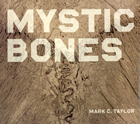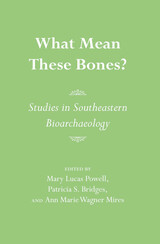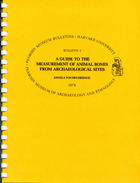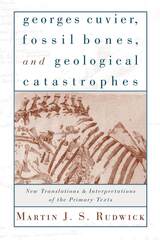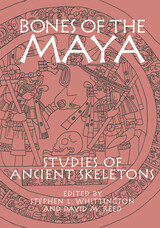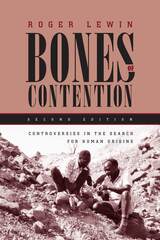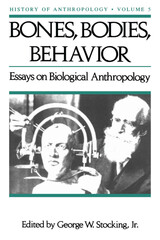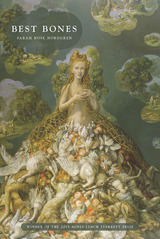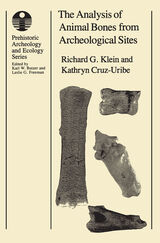BonesCollection by Cassandra Verhaegen (9 items)Books that will make you jitter with excitement. Don't hesitate to let your knowledge about bones be the skeleton in your closet. Includes the following tags:
American, Analysis, Animal Bones, Animal remains (Archaeology), Anthropometry, Archaeological Sites, Bones, Data processing, Deserts, Divination, Geology, Guide, Human beings, Human evolution, Human remains (Archaeology), Individual Photographers, Klein, Richard G., Maya, Mayas, Measurement, Nevada, Nordgren, Sarah Rose, Origin, Paleontology, Physical, Physical anthropology, Poetry, Powell, Mary Lucas, Smith, Bruce D., Studies, Taylor, Mark C.
See More
|
Mystic Bones
by Mark C. Taylor
University of Chicago Press, 2007
The desert has long been a theme in Mark C. Taylor’s work, from his inquiries into the religious significance of Las Vegas to his writings on earthworks artist Michael Heizer. At once haunted by absence and loss, the desert, for Taylor, is a place of exile and wandering, of temptation and tribulation. Bones, in turn, speak to his abiding interest in remnants, ruins, ritual, and immanence. Taylor combines his fascination in the detritus of the desert and its philosophical significance with his work in photography in Mystic Bones.
1
|
What Mean These Bones?
edited by Mary Lucas Powell, Ann Marie W. Mires and Patricia S. Bridges
contributions by Larry T. Tieszen, Christopher B. Ruff, Patricia Miller-Shaivitz, Mehmet Yascar Iscan, Tedw A. Rathbun, James D. Scurry, Bruce D. Smith, George R. Milner, Clark Spencer Larsen, Leslie Eisenberg, Jane E. Buikstra, Jerome C. Rose and Murray K. Marks University of Alabama Press, 1991
A Dan Josselyn Memorial Publication This volume addresses questions of human adaptation in a variety of cultural contexts, with a breadth not found in studies utilizing solely biological or artifactual data. These nine case studies from eight Southeastern states cover more than 4,000 years of human habitation, from Archaic hunter-gatherers in Louisiana and Alabama to Colonial planters and slaves in South Carolina. Several studies focus upon variations in health between or within late prehistoric agricultural societies. For example, the discovery that reliance upon maize as a dietary staple did not result invariably in poor health, as claimed by earlier studies, either for entire populations or, in ranked societies, for the non-elite majority, has fostered a new appreciation for the managerial wisdom of the Mississippian peoples, as well as for their agricultural skills.
2
|
A Guide to the Measurement of Animal Bones from Archaeological Sites
by Angela von den Driesch and Angela von den Driesch
Harvard University Press, 1976
Von den Driesch's handbook is the standard tool used by faunal analysts working on animal and bird assemblages from around the world. Developed for the instruction of students working on osteoarchaeological theses at the University of Munich, the guide has standardized how animal bones recovered from prehistoric and early historic sites are measured.
See More
3
|
Georges Cuvier, Fossil Bones, and Geological Catastrophes
by Martin J. S. Rudwick
University of Chicago Press, 1997
French zoologist Georges Cuvier (1769-1832) helped form and bring credibility to geology and paleontology. Here Martin J. S. Rudwick provides the first modern translation of Cuvier's essential writings on fossils and catastrophes and links these translated texts together with his own insightful narrative and interpretive commentary. "Martin Rudwick has done English-speaking science a considerable service by translating and commenting on Cuvier's work. . . . He guides us through Cuvier's most important writings, especially those which demonstrate his new technique of comparative anatomy."—Douglas Palmer, New Scientist
4
|
Bones of the Maya
edited by Stephen L. Whittington and David M. Reed
contributions by Carl Armstrong, Diane Z. Chase, Mark N. Cohen, Della Collins Cook, Andres del Angel, Robert E. Ferrell, Stephen L. Whittington, Karen D. Gettelman, Lorena M. Havill, Harold W. Krueger, Nora M. Olivares, Lourdes Marquez, Virginia K. Massey, D. Andrew Merriwether, Kathleen O'Conner, Oswaldo Chincilla Mazariegos, Frank P. Saul, Julie Mather Saul, D. Gentry Steele, Diane M. Warren, Lori E. Wright, Christine D. White, Jane E. Buikstra, John P. Gerry, Keith P. Jacobi, David M. Reed, Marie Elaine Danforth, Rebecca Storey and David L. Webster University of Alabama Press, 2006
Brings together for the first time a broad spectrum of bioarchaeologists and reveals remarkable data on Maya genetic relationship, demographic, and diseases
New techniques in osteology have yielded findings on Maya diet and health that challenge the ecological model of collapse. This benchmark collection of essays defined the state of Mayan skeletal studies. Its coverage spans the formative through colonial periods, with a geographic focus on the Maya lowlands of northern Guatemala, Belize, and western Honduras. Bringing together for the first time a broad spectrum of bioarchaeologists and revealing remarkable data on Maya genetic relationship, demographic, and diseases, the collection covers divers topics such as osteological, dental, bone chemistry, and DNA analyses. The diet and health status of Maya populations is a major theme, especially in relation to social status, gender, and the historical problem of the "collapse."
5
|
Bones of Contention
by Roger Lewin
University of Chicago Press, 1997
Bones of Contention is a behind-the-scenes look at the search for human origins. Analyzing how the biases and preconceptions of paleoanthropologists shaped their work, Roger Lewin's detective stories about the discovery of Neanderthal Man, the Taung Child, Lucy, and other major fossils provide insight into this most subjective of scientific endeavors. The new afterword looks at ways in which paleoanthropology, while becoming more scientific in many ways, remains contentious. "[An] un-put-downable book."—John Gribbon, Times Educational Supplement "Not just another 'stones and bones' account of human evolution. It is Lewin's thesis, amply demonstrated, that paleoanthropology is the most subjective of sciences because it engages the emotions of virtually everyone; and since the evidence is scrappy, interpretation is everything. . . . A splendid, stirring, and eye-opening account, to be devoured."—Kirkus Reviews, starred review "[Lewin shows] 'how very unscientific the process of scientific inquiry can be.'. . . Bones of Contention is . . . serious intellectual history."—Edward Dolnick, Wall Street Journal "[Lewin] documents his thesis in persuasive detail. . . . The reader is carried along by the power of Mr. Lewin's reporting."—Robert Wright, New York Times Book Review
6
|
Bones, Bodies amd Behavior
edited by George W. Stocking, Jr.
University of Wisconsin Press, 1990
History of Anthropology is a series of annual volumes, inaugurated in 1983, each broadly unified around a theme of major importance to both the history and the present practice of anthropological inquiry. Bones, Bodies, Behavior, the fifth in the series, treats a number of issues relating to the history of biological or physical anthropology: the application of the "race" idea to humankind, the comparison of animals minds to those of humans, the evolution of humans from primate forms, and the relation of science to racial ideology. Following an introductory overview of biological anthropology in Western tradition, the seven essays focus on a series of particular historical episodes from 1830 to 1980: the emergence of the race idea in restoration France, the comparative psychological thought of the American ethnologist Lewis Henry Morgan, the archeological background of the forgery of the remains "discovered" at Piltdown in 1912, their impact on paleoanthropology in the interwar period, the background and development of physical anthropology in Nazi Germany, and the attempts of Franx Boas and others to organize a consensus against racialism among British and American scientists in the late 1930s. The volume concludes with a provocative essay on physical anthropology and primate studies in the United States in the years since such a consensus was established by the UNESCO "Statements on Race" of 1950 and 1951. Bringing together the contributions of a physical anthropologist (Frank Spencer), a historical sociologist (Michael Hammond), and a number of historians of science (Elazar Barkan, Claude Blanckaert, Donna Haraway, Robert Proctor, and Marc Swetlitz), this volume will appeal to a wide range of students, scholars, and general readers interested in the place of biological assumptions in the modern anthropological tradition, in the biological bases of human behavior, in racial ideologies, and in the development of the modern human sciences.
7
|
Best Bones
by Sarah Rose Nordgren
University of Pittsburgh Press, 2014
Winner of the 2013 Agnes Lynch Starrett Poetry Prize Best Bones is a house. When you walk around the rooms of the house, you overhear the desires and griefs of a family, as well as the unresolved concerns of lingering ghosts. The various voices in the house struggle against the family roles and social identities that they must wear like heavy garments—mother, father, wife, husband, sister, brother, servant, and master. All these voices crave unification; they want to join themselves into one whole sentient being, into “a mansion steering itself.” The poems in Best Bones also explore the experience of living in a physical body, and how the natural world intersects with manmade landscapes and technologies. In it, mother has a reset button, servants blend into the furniture, and a doctor patiently oversees the pregnancy of the earth. In these poems, the body is a working machine, a repository of childhood myth and archetype, and a window to the spiritual world. The poems strive to be visceral on the level of dream, or of a story that is half remembered and half fabricated.
8
|
The Analysis of Animal Bones from Archeological Sites
by Richard G. Klein and Kathryn Cruz-Uribe
University of Chicago Press, 1984
In growing numbers, archeologists are specializing in the analysis of excavated animal bones as clues to the environment and behavior of ancient peoples. This pathbreaking work provides a detailed discussion of the outstanding issues and methods of bone studies that will interest zooarcheologists as well as paleontologists who focus on reconstructing ecologies from bones. Because large samples of bones from archeological sites require tedious and time-consuming analysis, the authors also offer a set of computer programs that will greatly simplify the bone specialist's job. After setting forth the interpretive framework that governs their use of numbers in faunal analysis, Richard G. Klein and Kathryn Cruz-Uribe survey various measures of taxonomic abundance, review methods for estimating the sex and age composition of a fossil species sample, and then give examples to show how these measures and sex/age profiles can provide useful information about the past. In the second part of their book, the authors present the computer programs used to calculate and analyze each numerical measure or count discussed in the earlier chapters. These elegant and original programs, written in BASIC, can easily be used by anyone with a microcomputer or with access to large mainframe computers.
9
|
| Click here to go to the beginning. | |||||||||
